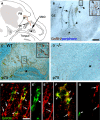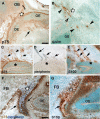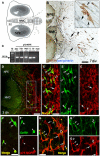P75 nerve growth factor receptors modulate development of GnRH neurons and olfactory ensheating cells
- PMID: 24409113
- PMCID: PMC3873506
- DOI: 10.3389/fnins.2013.00262
P75 nerve growth factor receptors modulate development of GnRH neurons and olfactory ensheating cells
Abstract
Temporal and spatial localization of nerve growth factor receptor (p75NGFR) in the developing olfactory system and gonadotropin-releasing hormone-1 (GnRH) system was characterized and its role analyzed using p75NGFR null mice and nasal explants. Prenatally, p75NGFR was expressed by GnRH neurons and olfactory ensheathing cells (OECs). In p75NGFR null mice, no change in the number of GnRH cells was detected as compared to wild-type. However, in null mice, a shift in the distribution of GnRH neurons was found, with a small population of GnRH cells migrating further caudally toward the median eminence. Additionally, a reduction of both GAD67 positive olfactory axons and GFAP positive OEC fibers occurred. Acute administration of a p75NGFR blocker to GnRH cells maintained in vitro increased migration rate, consistent with the change in distribution detected in p75NGFR null mice. Chronic inhibition of p75NGFR caused an attenuation of olfactory axon fasciculation and a decrease in OEC density, again mimicking the changes detected in null mice. However, a reduction in GnRH cell number was found after chronic treatment that not observed in KO animals suggesting indirect changes occur during chronic treatment in vitro and/or a compensatory mechanism occurs in vivo that prevents loss of GnRH neurons in the absence of p75NGFR.
Keywords: LHRH neurons; development; migration; olfactory ensheathing cells; olfactory system.
Figures








Similar articles
-
GPR37 Signaling Modulates Migration of Olfactory Ensheathing Cells and Gonadotropin Releasing Hormone Cells in Mice.Front Cell Neurosci. 2019 May 9;13:200. doi: 10.3389/fncel.2019.00200. eCollection 2019. Front Cell Neurosci. 2019. PMID: 31143101 Free PMC article.
-
Gli3 Regulates Vomeronasal Neurogenesis, Olfactory Ensheathing Cell Formation, and GnRH-1 Neuronal Migration.J Neurosci. 2020 Jan 8;40(2):311-326. doi: 10.1523/JNEUROSCI.1977-19.2019. Epub 2019 Nov 25. J Neurosci. 2020. PMID: 31767679 Free PMC article.
-
Olfactory ensheathing cells abutting the embryonic olfactory bulb express Frzb, whose deletion disrupts olfactory axon targeting.Glia. 2018 Dec;66(12):2617-2631. doi: 10.1002/glia.23515. Epub 2018 Sep 26. Glia. 2018. PMID: 30256452 Free PMC article.
-
Gonadotropin-releasing hormone containing neurons and olfactory fibers during development: from lamprey to mammals.Brain Res Bull. 1997;44(4):479-86. doi: 10.1016/s0361-9230(97)00229-3. Brain Res Bull. 1997. PMID: 9370214 Review.
-
Gonadotropin-releasing hormone neuronal migration.Semin Reprod Med. 2007 Sep;25(5):305-12. doi: 10.1055/s-2007-984736. Semin Reprod Med. 2007. PMID: 17710726 Review.
Cited by
-
Enhancing the Therapeutic Potential of Olfactory Ensheathing Cells in Spinal Cord Repair Using Neurotrophins.Cell Transplant. 2018 Jun;27(6):867-878. doi: 10.1177/0963689718759472. Epub 2018 May 31. Cell Transplant. 2018. PMID: 29852748 Free PMC article. Review.
-
Nasal Placode Development, GnRH Neuronal Migration and Kallmann Syndrome.Front Cell Dev Biol. 2019 Jul 11;7:121. doi: 10.3389/fcell.2019.00121. eCollection 2019. Front Cell Dev Biol. 2019. PMID: 31355196 Free PMC article.
-
Selective Cre-mediated gene deletion identifies connexin 43 as the main connexin channel supporting olfactory ensheathing cell networks.J Comp Neurol. 2019 May 1;527(7):1278-1289. doi: 10.1002/cne.24628. Epub 2019 Jan 21. J Comp Neurol. 2019. PMID: 30628061 Free PMC article.
-
GPR37 Signaling Modulates Migration of Olfactory Ensheathing Cells and Gonadotropin Releasing Hormone Cells in Mice.Front Cell Neurosci. 2019 May 9;13:200. doi: 10.3389/fncel.2019.00200. eCollection 2019. Front Cell Neurosci. 2019. PMID: 31143101 Free PMC article.
-
Characteristics of olfactory ensheathing cells and microarray analysis in Tupaia belangeri (Wagner, 1841).Mol Med Rep. 2019 Aug;20(2):1819-1825. doi: 10.3892/mmr.2019.10422. Epub 2019 Jun 25. Mol Med Rep. 2019. PMID: 31257532 Free PMC article.
References
Grants and funding
LinkOut - more resources
Full Text Sources
Other Literature Sources
Molecular Biology Databases
Research Materials
Miscellaneous

